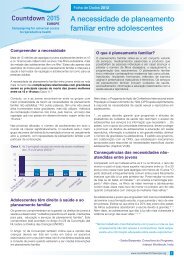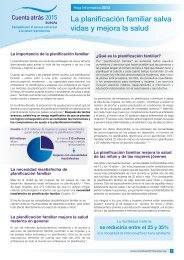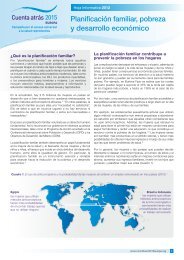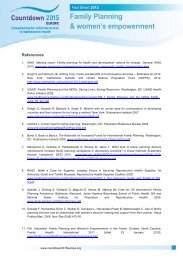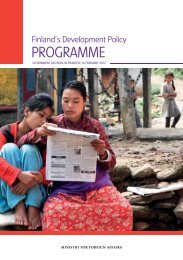4.2 Facts and statistics: benefits of investing in family planning••Every US dollar spent on family planning saves at least US$4that would otherwise be spent on treating complicationsfrom unintended pregnancies (UN Secretary General 2010).••If all women at risk of unintended pregnancy used moderncontraceptive methods, the declines in unintendedpregnancy and unsafe abortion would reduce the cost ofpost-abortion care by approximately US$140 million a year(Singh, Darroch et al. 2009; Guttmacher 2010).••30–50% of Asia’s economic growth from 1965 to 1990 hasbeen attributed to changes in population dynamics, whichare strongly influenced by improvements in reproductivehealth and access to contraception (UN Secretary General2010; Bloom & Williamson 1998).••Lower fertility accounts <strong>for</strong> 25–40% of economic growth indeveloping countries (Barot 2008; UK APPG on Population,Development and Reproductive Health 2009).••Maternal mortality would drop by 25–35% if the unmet need<strong>for</strong> modern contraceptives were fulfilled, saving the lives ofclose to 100,000 women each year (Barot 2008).••<strong>The</strong> level of modern contraceptive use averts 188 millionunintended pregnancies each year (Guttmacher/IPPF 2010),which in turn helps prevent 230,000 pregnancy-relateddeaths and other negative health outcomes (Singh, Darrochet al. 2009).••Meeting the unmet need would mean that more than halfa million fewer children would lose their mothers (Singh,Darroch et al. 2009; Guttmacher/IPPF 2010).••If women had the means to space their births three yearsapart, infant and under-five mortality rates would drop by24% and 35%, respectively (Barot 2008).••If there were at least two years between a birth and asubsequent pregnancy, deaths of children under-five wouldfall by 13%; if the gap were three years, such deaths woulddecrease by 25% (Rutstein 2008)••As contraceptive use increases, rates of abortion decrease:the current level of modern contraceptive use is estimated toprevent 112 million abortions every year (Guttmacher/IPPF2010).4.3 Facts and statistics: progress and setbacks in addressing unmet need••Between 1965 and 2005, use of family planning in developingregions (excluding China) rose from less than 10% to justover 50% (Speidel, Sinding et al. 2009).••<strong>The</strong> number of contraceptive users grew from approximately30 million to 430 million from 1965 to 2005, resulting indecline of more than six children born to each woman duringher lifetime, to just over three children (Speidel, Sinding etal. 2009).••By 2007, approximately 60% of married women ofreproductive age were using some <strong>for</strong>m of contraception(UN-DESA 2011).••<strong>The</strong> unmet need <strong>for</strong> family planning has remained at the samemoderate to high level in most regions since 2000 (UN 2011).••As a proportion of total aid <strong>for</strong> health, aid <strong>for</strong> family planningdeclined over the past ten years in virtually all recipientcountries (UN 2011).••In sub-Saharan Africa, unmet need has declined little overthe past decade, and in a few countries unmet need hasincreased (Guttmacher/IPPF 2010; UN 2011).••Data from 22 countries show that the percentage ofadolescents who have their demand <strong>for</strong> contraceptionsatisfied is much lower than that of all women aged 15 to49. This disparity has changed little over time, pointing toscant progress in improving access to reproductive healthcare <strong>for</strong> adolescents (UN 2011).4.3.1 Quotes: progress and set-backs in addressing unmet needMany regions still do not have comprehensive services“In 2007, the Government declared a state of emergency <strong>for</strong>maternal health, which made it possible <strong>for</strong> expectant mothers whohave registered under the National Health Insurance Scheme to getfree antenatal and delivery care. This was a laudable initiative, butthe Government also needs to make services available <strong>for</strong> womenwho are not giving birth by providing free contraceptives and familyplanning services. If you want to address maternal health, youneed a comprehensive package, including family planning on theNational Health Insurance Scheme will help address this.”– Nana Amma O<strong>for</strong>iwaa Sam,Advocacy Officer, Planned Parenthood Association of Ghana“India’s flagship national health programme – the National RuralHealth Programme – primarily focuses on family planning,reproductive health and maternal health. But family planning is themost under-implemented aspect. <strong>The</strong> focus is on maternal health,and people haven’t yet made the connection between maternalhealth and family planning.”– Sarita Barpanda,Country Programme Advisor, Interact Worldwide, India“About 45% of people in Ghana are under age 18, and theNational Health Insurance Scheme provides free services to thoseunder 18. If you are over 18, though, you have to work to pay <strong>for</strong>services. For us it’s a good start, but not the end of the story.”– Nana Amma O<strong>for</strong>iwaa Sam,Advocacy Officer, Planned Parenthood Association of Ghana“Cairo was an extraordinary conference. It was the first time weheard about rights and a holistic conception of reproductive health.But if we observe fertility trends in many countries, it is clear thatwe are not achieving what we set out to achieve.”– Esperanza Delgado, Director of In<strong>for</strong>mation and Evaluation, MEXFAMMen are left out of family planning“We used to give out condoms, but now we can’t get regularsupplies. In the documentary video we made, in the KwahuSouth District of Ghana, one of the community agents remarked‘<strong>The</strong> young men come to you in the middle of the night, and wedon’t have them, and it’s bad news. <strong>The</strong>y say, ‘we have to doit sacora – without a condom.’ That means ‘like a bald head’or ‘bald-headed person’. In this case, it’s a bald-headed penis!20 www.countdown<strong>2015</strong>europe.org
Everyone laughs at the remark, but it’s all too common that theycan’t access condoms. We have to include men in our plans toaddress unmet need, too.”– Nana Amma O<strong>for</strong>iwaa Sam,Advocacy Officer, Planned Parenthood Association of GhanaStock-outs of supplies are common“In a hospital in northern Uganda, we experienced stockoutsof contraceptives: condoms, injectables (which is themost common method) and implants. We only had pills, sothe method mix wasn’t there. If a woman is on injectables andwe only have pills, the woman just leaves with no protection.Though there is a wide belief in some circles that pills areconvenient, in Ghana this is not always the case. It’s difficultto disguise if you have to take a pill every day, but if you walkthe distance to get injections only every three months, yourhusband doesn’t know.”– Dr. Moses Muwonge, M.D., Health Logistics Consultant, Uganda“In 1995 and1996 I was working in a conflict area, and therewere stock-outs of contraceptives. <strong>The</strong> women would comein the evening and then return home in the morning, as mostfamilies would sleep on the streets in the cities where it wassafer than the villages … Women wanted family planning butcouldn’t get it. <strong>The</strong> stock-out was at country level, yet othermedicines were coming through despite the conflict.”– Dr. Moses Muwonge, M.D., Health Logistics Consultant, Uganda“We spoke with a doctor who is responsible <strong>for</strong> reproductivehealth programmes in Mexico’s third largest state. She wasvery worried because her state simply does not have thecontraceptives that women need. We looked into this and foundthat, although her state received an allotted amount of moneyspecifically <strong>for</strong> contraceptives, it never reached her office. Aftera great deal of investigation it became clear that there is a lawrequiring budget integrity and transparency on the part of thecentral government, but it does not apply at state level. Asa result, the Minister of Health has documentation showingthat the Government is investing funds in family planning andsupplies, and it looks like a great success. But you discover thetruth when you go to the states, where contraceptive suppliesare needed and there isn’t sufficient funding <strong>for</strong> them.Although at central level the Ministry of Health disburses funds<strong>for</strong> family planning, the money is received at state level by theMinistry of Finance rather than Health. Once funds reach thestates, the governors can decide where that money goes: itcan decide there are more important priorities than reproductivehealth and family planning. MEXFAM is now advocating tochange this.”– Esperanza Delgado,Director of In<strong>for</strong>mation and Evaluation, MEXFAM“We started seeing stock-outs of contraceptive supplies. <strong>The</strong>reis a specific labelled budget line <strong>for</strong> family planning, so we wentto the central Government and asked why there were stockouts. <strong>The</strong>y said they did not know. In Mexico, the decentralizedsystem means that all 32 states have to follow the model setat the central level, yet this is not the case with regard to thebudget.”– Esperanza Delgado,Director of In<strong>for</strong>mation and Evaluation, MEXFAMContraceptives are expensive <strong>for</strong> many users andorganizations“<strong>The</strong> <strong>Family</strong> <strong>Planning</strong> Association of the Philippines has 25chapters, all of which are clinics providing services, such ascounselling, as well as contraceptives. However, we still seekdonations <strong>for</strong> our commodities because we have to recover thecosts. Although the contraceptives we get from IPPF are free,when the shipments arrive in the Philippines we have to paytaxes on them of around 12%. For us to be exempt from payingthese taxes, we have to be included in the law that mandatessuch exemption, but we’re not.”– Bryant Gonzales,Youth Coordinator, <strong>Family</strong> <strong>Planning</strong> Association of the Philippines“We’ve talked about price with people, and frankly people prefercontraceptives to be free. However, they don’t have much faithin what’s being provided <strong>for</strong> free by governments. For example,at a Q&A session with adolescents, we were talking aboutmyths and misconceptions, and one thing that came out wasthat government-provided male condoms often break. This isbecause they aren’t stored properly or were expired. <strong>The</strong>seare some of the things we’ve heard from young people, andreasons why, even where governments are providing servicesand supplies, there is less reliance on these sources. Inaddition, there are no good storage facilities within governmentinstitutions, so there is this feeling that the government-providedcontraceptives are not good products that people can usewith faith. As a result, there’s always a dependence on privateproviders, getting it from the chemists or pharmacy, which ismuch easier, but there is still limited choice.”– Sarita Barpanda,Country Programme Advisor, Interact Worldwide, IndiaPeople know about family planning, but can’t get thesupplies and services they need“I believe in family planning. I believe in all of the benefits thatfamily planning provides to individuals and communities and inpolitical life. Just because a country ‘develops’ economicallydoes not mean that it does not require funding and programmes<strong>for</strong> family planning. It just requires these in a different way.<strong>Family</strong> planning is a never-ending story.”– Esperanza Delgado,Director of In<strong>for</strong>mation and Evaluation, MEXFAM“In my experience at community level, working with men andwomen, separately and collectively as couples, there wasminimal resistance but a lot of curiosity. I don’t question thedemographics that say knowledge of family planning is at 96%.People know about the pill and other methods, they may havemisunderstandings, but the big problem is they can’t access it.”– Holo Hochanda, Zambian Commission on Population andDevelopment delegation, BroadReach Healthcare, Zambia“One reason why knowledge about family planning is nearlyuniversal is because you have many [civil society organizations(CSOs)] working on this, and you have things like radio stationsthat reach many people. But the reach of the messages is notas good as the reach of the family planning and public healthfacilities. If someone is within 20 kilometres of a village, theyknow about family planning, because CSOs have meetings inthe villages. <strong>The</strong> question is, once I have the knowledge, wherecan I access the services? That is <strong>for</strong> the public sector. <strong>The</strong>www.countdown<strong>2015</strong>europe.org21








